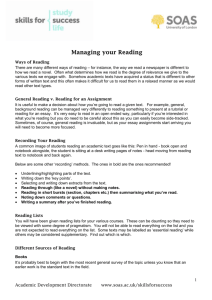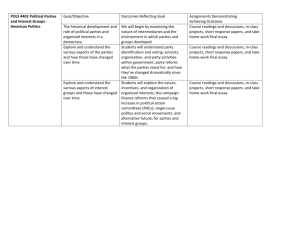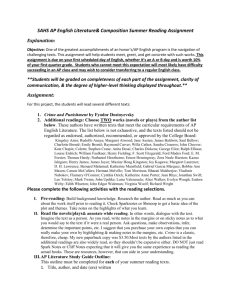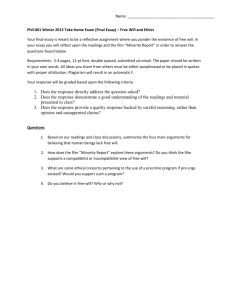English Department Assessment Report Spring 2012 a (
advertisement
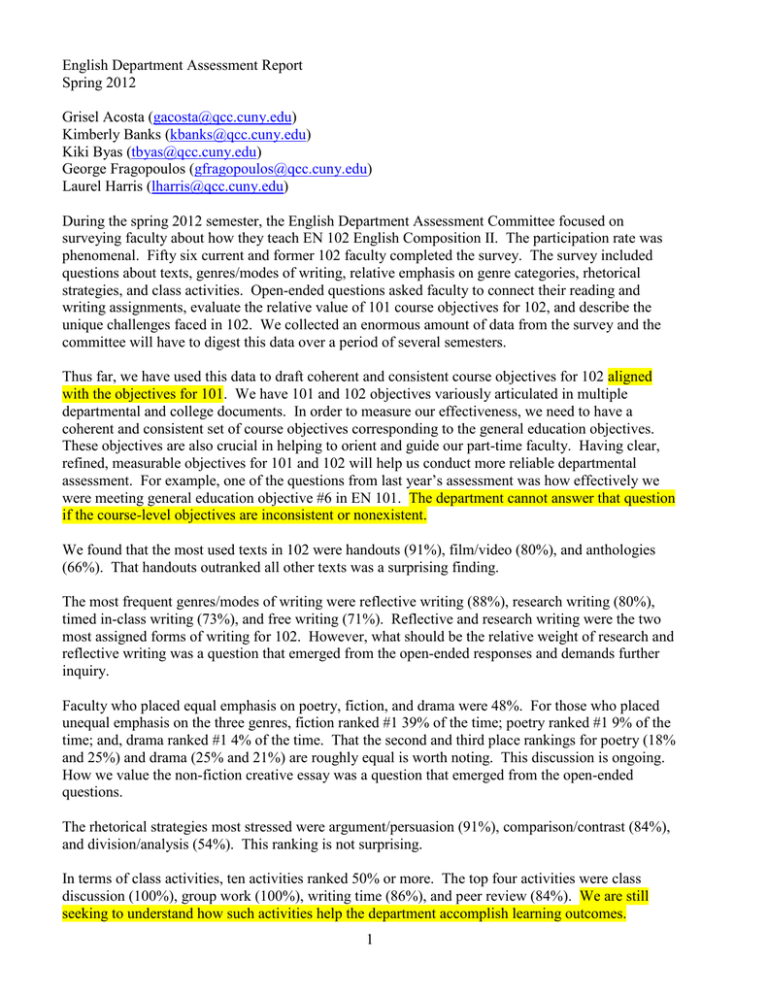
English Department Assessment Report Spring 2012 Grisel Acosta (gacosta@qcc.cuny.edu) Kimberly Banks (kbanks@qcc.cuny.edu) Kiki Byas (tbyas@qcc.cuny.edu) George Fragopoulos (gfragopoulos@qcc.cuny.edu) Laurel Harris (lharris@qcc.cuny.edu) During the spring 2012 semester, the English Department Assessment Committee focused on surveying faculty about how they teach EN 102 English Composition II. The participation rate was phenomenal. Fifty six current and former 102 faculty completed the survey. The survey included questions about texts, genres/modes of writing, relative emphasis on genre categories, rhetorical strategies, and class activities. Open-ended questions asked faculty to connect their reading and writing assignments, evaluate the relative value of 101 course objectives for 102, and describe the unique challenges faced in 102. We collected an enormous amount of data from the survey and the committee will have to digest this data over a period of several semesters. Thus far, we have used this data to draft coherent and consistent course objectives for 102 aligned with the objectives for 101. We have 101 and 102 objectives variously articulated in multiple departmental and college documents. In order to measure our effectiveness, we need to have a coherent and consistent set of course objectives corresponding to the general education objectives. These objectives are also crucial in helping to orient and guide our part-time faculty. Having clear, refined, measurable objectives for 101 and 102 will help us conduct more reliable departmental assessment. For example, one of the questions from last year’s assessment was how effectively we were meeting general education objective #6 in EN 101. The department cannot answer that question if the course-level objectives are inconsistent or nonexistent. We found that the most used texts in 102 were handouts (91%), film/video (80%), and anthologies (66%). That handouts outranked all other texts was a surprising finding. The most frequent genres/modes of writing were reflective writing (88%), research writing (80%), timed in-class writing (73%), and free writing (71%). Reflective and research writing were the two most assigned forms of writing for 102. However, what should be the relative weight of research and reflective writing was a question that emerged from the open-ended responses and demands further inquiry. Faculty who placed equal emphasis on poetry, fiction, and drama were 48%. For those who placed unequal emphasis on the three genres, fiction ranked #1 39% of the time; poetry ranked #1 9% of the time; and, drama ranked #1 4% of the time. That the second and third place rankings for poetry (18% and 25%) and drama (25% and 21%) are roughly equal is worth noting. This discussion is ongoing. How we value the non-fiction creative essay was a question that emerged from the open-ended questions. The rhetorical strategies most stressed were argument/persuasion (91%), comparison/contrast (84%), and division/analysis (54%). This ranking is not surprising. In terms of class activities, ten activities ranked 50% or more. The top four activities were class discussion (100%), group work (100%), writing time (86%), and peer review (84%). We are still seeking to understand how such activities help the department accomplish learning outcomes. 1 The survey included an analysis of EN 101 English Composition I course objectives and how relevant faculty thought such objectives were for assessing 102. Respondents rated the six 101 objectives as equally important; however, the course objective consistent with the first general education objective received the most support. Several documents provide different formulations for EN 101 and 102 course objectives. The committee is developing a consistent set of objectives to appear in all official documents of the department and college. Of note is the fact that 101 and 102 only share two general education objectives, #1 and #6. Otherwise, the other general education objectives relevant for 102 are #2 and #10. Objectives #4 and #7 are only relevant for 101. Examining more carefully how 101 and 102 meet common objectives as well as the challenges of their distinct objectives should give us more insight into why the retention rate for 101 is much higher than for 102. Comments about the unique challenges of teaching 102 have helped the committee develop a set of preliminary course-specific objectives. The committee will finalize 101, 102 and 103 objectives in the fall. They will be presented to the department and incorporated into Teaching First-Year Writing: A QCC Handbook. 2 English 101 Assessment Project Updated Final Report January 22, 2008 Summary Discussion: a. Findings of the EN-101 Assessment: • • • • The EN-101 final examination is an effective measurement of the first general education objective, “Students will write, read, listen, and speak clearly and effectively” (see “Faculty Data Sheet Summary, question 1, attached). The CPE rubric is an effective measure of student achievement of the General Education Objective (see “Faculty Data Sheet Summary, question 2, attached). The opportunity for departmental discussion and reform of the EN-101 curriculum is great (see discussion below). In the Fall, 2004 semester, 83% of LS1 students completed the course. 91.1% received a grade of C or better. b. Resulting Action Plan: • • Faculty will continue experimenting with assigning various genres of academic writing, such as ethnography and the literacy narrative. The Department will hold an exploratory meeting on uses of the e-portfolio. c. Post-Assessment Findings: As a result of both the EN-101 and EN-102 Assessment Projects, the English Department has taken or will take the following courses of action: • • • • • • • Meet with Anna May Jagoda (Director, Institutional Research) to determine the consistency of the withdrawal rates for EN-101 and EN-102 courses Administer a Pilot Withdrawal questionnaire to determine why students withdraw from EN-101 Consider a further step in redesigning the EN-101 research project to reflect students’ need to become familiar with the various genres of academic writing across the curriculum Develop writing assignments based on ethnographic approaches Pilot reflexive writing genre for anticipated e-portfolio installation Experiment with and participate in the e-portfolio pilot project Continue with assigning various genres of academic writing including ethnography, literacy narratives, and project based learning and with other samples of student writing that will be incorporated into e-portfolio d. Additional Post-Assessment Findings: The English Department engaged in several discussions resulting from data generated by the EN-101 and EN-102 course assessment projects. The disparity between the completion rates of these 3 courses has generated significant discussion about linkages between them, and these conversations formed the basis of both department and composition committee meetings. Discussions focused upon topics that concerned both course objectives (genre, first day writing assignments, “the essay”) and pedagogy (e-portfolios, ethnography, literacy narratives, project-based learning). Of course, the interrelationship of course objectives and pedagogy informed all discussions. Fall 2006: • The pedagogy of an EN-101 class based upon ethnography was the basis for a departmental conversation about the relationships among pedagogy, product, and instructor response. It became evident that instructors need to be clear with students about what we value as readers/writers/teachers/evaluators and that these values be reflected in our written course objectives. • Examination of a student essay stimulated a discussion/debate about an instructor’s objectives in assigning writing: the need for clear assignment instructions, the sometimes-fine line between teaching students how to write the “college essay” genre and limiting creativity, and the tension between deep revision and the loss of initial inspiration. • A discussion of the multiple types of genre assigned evolved into a conversation about how the definition of a “paper” (a genre often only vaguely representing “real” genres in the “real” world) is instructor-specific and is dependent upon individual pedagogy, academic discipline, and education. Spring 2007: • The pedagogical implications of a first-day writing assignment: how it immediately establishes varied course objectives, including focus upon writing, active participation, and the improvement of writing skills. Literacy narratives were presented as a model first-day assignment and as a possible e-portfolio project. • Project-based learning: How assigning projects incorporate additional learning objectives and learning skills, such as writing and technology. • The e-portfolio initiative. Susan Lambert spoke with the Department about the college’s progress in instituting e-portfolios, her role in the project, and the possible role of English department faculty in the future. e. Attached Documents: • • • EN-101 Course Assessment Project Tables 1 - 5 Faculty Data Sheet Summary CUNY Proficiency Examination Scoring Guide 4 QCC INDIVIDUAL COURSE ASSESSMENT PROJECT FALL 2002 Department: English Course: 101 Curriculum: Liberal Arts 1. Educational Context Course: English 101: Freshman Composition I Curriculum: Associate in Arts (A.A.) Degree in Liberal Arts English 101 is an entry-level course required by all curricula. Students work on acquiring writing skills and on developing a critical sensibility that will enable them to learn such essentials of writing as purpose, situation, audience, form, tone, and style. The focus is on learning to write effective essays, both personal and expository. In addition, students learn to see the connections between reading and writing and the ways in which research extends both. 3. General Education Objectives General educational objectives addressed by this course Briefly describe activities in the course which help students meet each of these general education objectives 1. Students will write, read, listen, and speak clearly and effectively. Students compose and revise multiple drafts of essays. Students summarize, analyze, and synthesize texts. Students demonstrate an ability to find sources of information. Students evaluate, cite, and document sources. Students analyze texts and ideas from multiple points-of-view. Students assert and support their own texts and ideas and evaluate the implications of those texts and ideas. 2. Students will use information management skills effectively for academic research and lifelong learning. 3. Students will differentiate and make informed decisions about issues based on value systems (ethical, philosophical, religious, cultural, and political). 4. Course Objectives: Desired Student Learning What should students be able to do by the time they finish the course? 5 Write the major learning objectives for students in this course (no more than 10). Note that each objective should begin with an action verb, completing the sentence, “Students will _________________. ” See excerpt from Lion Gardiner workshop materials below. 1. Students will compose and revise multiple drafts of essays. 2. Students will summarize, analyze, and synthesize texts. 3. Students will demonstrate an ability to find sources of information. 4. Students will evaluate, cite, and document sources. 6 5. Student Learning Outcomes Course objectives (Note: copy objectives from table above. ) Learning outcomes (Note that each outcome should begin with an action verb, completing the sentence, “Students will ____________. ”) 1. Students will compose and revise multiple drafts of essays. 2. Students will read texts critically in order to analyze ideas from multiple points of view. 3. Students will expand their thinking through informal and formal research. 4. Students will evaluate, cite, and document sources. a. Students will write essays using various rhetorical strategies. b. Students will revise essays based upon self-reflection and feedback from instructors and/or peers. a. Students will identify rhetorical elements and summarize key points in texts. b. Students will compare different readers’ understanding and interpretation of texts. a. Students will collect ideas and information through personal interview, reading, library, and Internet research. b. Students will evaluate and synthesize information with their thinking on a subject and properly cite research with MLA and/or APA documentation. a. Students will judge the value and relevance of source materials and avoid plagiarism by documenting them. b. Students will use MLA and APA documentation to cite sources. 7 EN-101 Assessment Project Faculty Data Sheet Summary (1) How well does your final examination assignment measure the General Education learning objective “Students will write, read, listen, and speak clearly and effectively.” Write Read *25 25 Listen Speak 17 10 * Number of positive faculty responses (2) How well does the CUNY Proficiency Examination Scoring Guide measure your students’ performance on the final examination assignment? Not At All 0 Somewhat Well 4 12 Very Well 12 Number of participating faculty: 28 8 A Develops an essay that presents a focused response to the writing assignment, making appropriate and coherent connections among all parts of the assignment. B Demonstrates understanding of the readings through summary and explanation of relevant material. C Incorporates, as support for own thoughts, references to the readings, identifying the sources formally or informally. D Communicates clearly and effectively, using appropriate conventions of language (e.g., grammar, spelling, punctuation). 8 9 7 4 5 3 9 11 Question (3) With regard to the CUNY Proficiency Examination Scoring Criteria, which area did your students perform best on? (4) Which CPE area was the weakest for your students? Number of participating faculty: 28 Number of participating students: 560 9 CUNY Proficiency Examination Scoring Guide A. Develops an essay that presents a focused response to the writing assignment, making appropriate and coherent connections among all parts of the assignment. B. Demonstrates understanding of the readings through summary and explanation of relevant material. C. Incorporates, as support for own thoughts, references to the readings, identifying the sources formally or informally. D. Communicates clearly and effectively, using appropriate conventions of language (e.g., grammar, spelling, punctuation). 6 Addresses the writing assignment fully, analytically, and perhaps critically or imaginatively, with superior focus and coherence. 6 Demonstrates superior and perhaps critical understanding of readings through accurate summary, full explanation, and insightful analysis of relevant sections. 6 Makes insightful connections and distinctions between readings and own ideas; integrates references smoothly into own essay and identifies them consistently and correctly. 6 Communicates with precision and enhanced expression through highly effective use of vocabulary and sentence variety; infrequent, if any, lapses in use of conventions. 5 Addresses the writing assignment fully and analytically, with strong focus and coherence. 5 Demonstrates strong understanding of readings through accurate summary, with appropriate explanation and analysis of relevant sections. 5 Makes analytical connections and perhaps distinctions between readings and own ideas; integrates references into own essay and identifies them consistently and correctly. 5 Communicates effectively throughout the essay, with few lapses in use of conventions. 4 Addresses all parts of the writing assignment with adequate focus and coherence throughout. 4 Demonstrates overall understanding of readings through appropriate summary and explanation, with some analysis. 4 Makes and explains appropriate connections between readings and own ideas; identifies references consistently and correctly. 4 Communicates clearly throughout the essay; sentences may contain some lapses in use of conventions, but these rarely impede comprehension. 3 Addresses all or most parts of the writing assignment adequately, but focus may lapse briefly or connections may be missing. 3 Demonstrates generally accurate understanding of readings although summary or explanation may be incomplete or not fully relevant. 3 Makes some connections between readings and own ideas but they may not all be appropriate or adequately explained; identifies most references consistently and correctly. 3 Generally communicates clearly throughout the essay although lapses in use of conventions may at times impede comprehension or prove distracting. 2 Addresses some parts of the writing assignment or addresses all parts superficially; focus or coherence may break down at several points. 2 Demonstrates partial understanding of the readings through summary or explanation, but understanding is flawed or explanation is incomplete. 2 Makes few or unwarranted connections between readings and own ideas; may identify references inconsistently or incorrectly. 2 Communicates clearly at times, showing some ability to use conventions, but whole sections are unclear or errors frequently impede comprehension. 1 Shows little or no ability to address the writing assignment; may not link thoughts between paragraphs. 1 Demonstrates little or no understanding of text. 1 Makes no reference to background reading or makes no distinctions between background reading and own ideas. 1 Communicates little because few sentences demonstrate appropriate use of conventions. Number of participating faculty: 28 Number of participating students: 560 10
